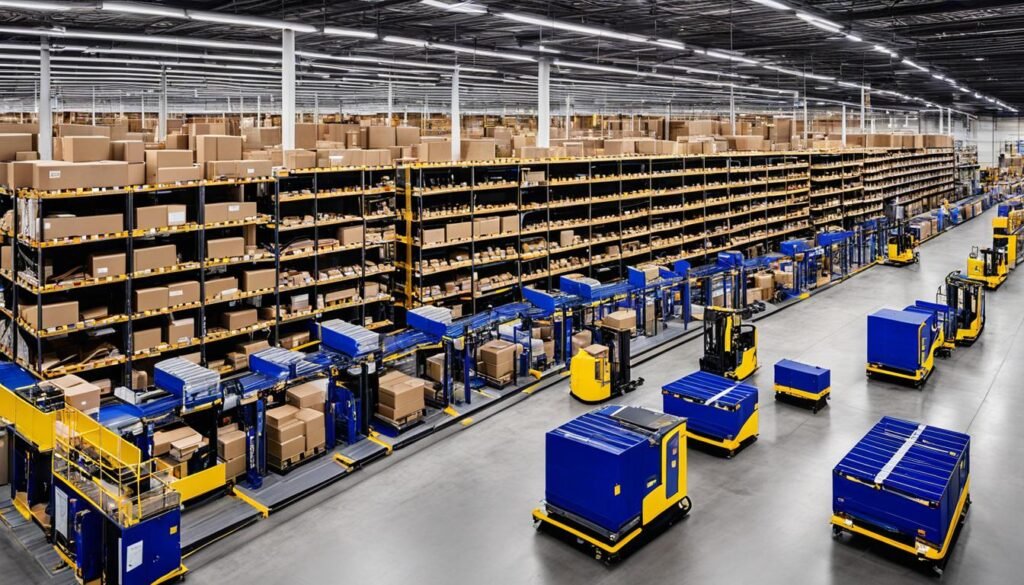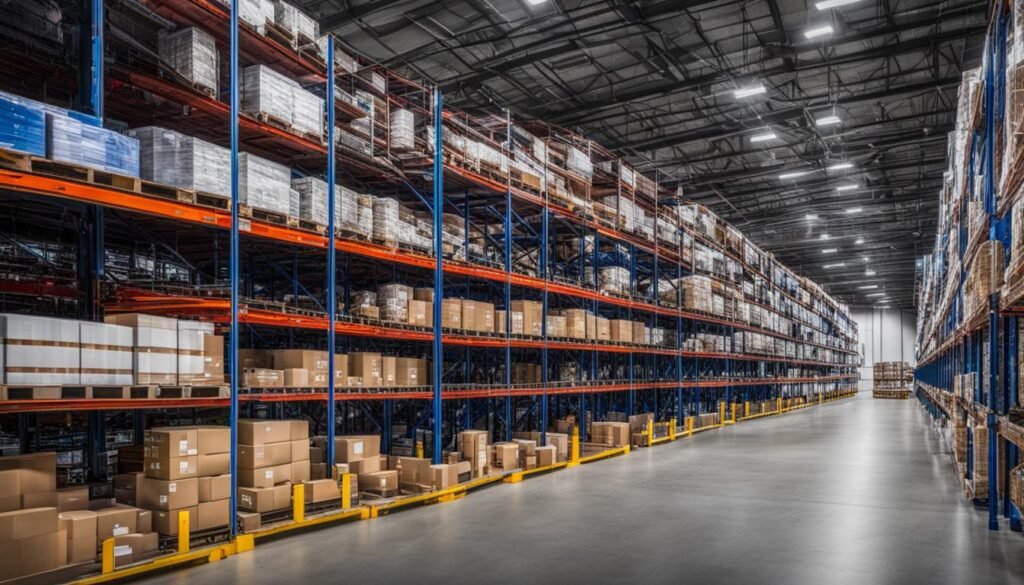Warehousing and shipping are critical aspects of running a successful ecommerce business. Efficient warehouse operations can greatly impact customer satisfaction, return rates, and overall profitability. By optimizing your ecommerce warehouse, you can streamline inventory management and fulfillment processes, leading to improved customer experiences and increased revenue.
One of the key factors in optimizing your warehouse operations is implementing a robust Warehouse Management System (WMS). A WMS is a software solution that helps you efficiently manage inventory, track orders, and automate various warehouse tasks. With a WMS in place, you can easily monitor stock levels, oversee order fulfillment, and ensure accurate inventory counts.
Key Takeaways:
- An optimized ecommerce warehouse is crucial for customer satisfaction and profitability.
- Implementing a Warehouse Management System (WMS) can streamline inventory management and order fulfillment.
- A WMS helps track stock levels, automate warehouse tasks, and ensure accurate inventory counts.
- Efficient warehouse operations lead to improved customer experiences and increased revenue.
- Stay ahead of the competition by optimizing your ecommerce warehouse operations.
Optimize Warehouse Layout and Storage
Optimizing your warehouse layout and storage is key to improving efficiency and maximizing space utilization in your ecommerce warehouse. One effective technique to achieve this is warehouse slotting, which involves strategically assigning storage locations for each product to enable faster order picking and minimize unnecessary movements within the warehouse.
Investing in a reliable warehouse management system (WMS) can greatly assist in optimizing your warehouse operations. A WMS acts as a centralized platform that analyzes data and considers various factors such as receiving, storage, forward staging, shipping, and returns. By leveraging advanced algorithms and real-time data, a WMS helps you make informed decisions about the most optimal storage locations and allocation of resources.
“Optimizing warehouse layout and storage is crucial for efficient inventory management and fulfillment. By implementing warehouse slotting techniques and utilizing a robust warehouse management system, ecommerce businesses can streamline their operations and maximize storage space.”
Warehouse slotting not only enables faster order fulfillment but also improves inventory accuracy and minimizes the chances of mispicks. By organizing your warehouse based on product characteristics, such as size, weight, popularity, or expiration date, you can reduce unnecessary travel time and enhance productivity.
Additionally, an optimized warehouse layout and storage system can help your warehouse staff locate products more easily, improving their efficiency and reducing errors. A well-planned layout provides clear pathways and minimizes congestion, ensuring smooth movement of goods throughout the facility.
Implementing an efficient warehouse layout and storage system also allows you to maximize your storage space. By analyzing data on product demand and velocity, you can allocate prime storage locations to fast-moving items and utilize less accessible areas for slower-moving stock. This strategy helps balance inventory levels, minimizes the need for overflow storage, and optimizes overall warehouse capacity.
To visualize the benefits of warehouse layout optimization, consider the following table that showcases the impact of warehouse slotting on order picking efficiency and storage utilization:
| Warehouse Slotting Strategy | Order Picking Efficiency | Storage Utilization |
|---|---|---|
| Randomized Storage | Low | Suboptimal |
| ABC Classification | Medium | Reasonable |
| Product Velocity-Based Slotting | High | Optimal |
By implementing a systematic approach to warehouse layout and storage optimization, ecommerce businesses can considerably improve their operations, reduce costs, and enhance customer satisfaction through quicker order fulfillment.
Consider Essential Equipment

When it comes to optimizing your ecommerce warehouse, having the right equipment is essential. The use of appropriate warehouse equipment can greatly impact the efficiency and effectiveness of your operations. Here are some key types of equipment that you should consider:
1. Storage Equipment
Investing in quality storage equipment, such as storage racks, can help you maximize your warehouse space and improve inventory management. With proper organization and utilization of storage equipment, you can ensure easy access to products, streamline picking processes, and enhance overall goods flow.
2. Material Handling Equipment
Efficient material handling is crucial for smooth warehouse operations. Equipment such as forklifts, pallet jacks, and conveyors can significantly improve productivity by reducing manual labor and minimizing the risk of product damage during transportation. By investing in material handling equipment, you can streamline the movement of goods and optimize your workflow.
3. Packing and Shipping Equipment
To meet the demands of ecommerce fulfillment, it is important to have the right packing and shipping equipment. This includes equipment such as packing stations, tape dispensers, weighing scales, and label printers. By equipping your warehouse with these tools, you can ensure accurate and efficient packing and shipping processes, leading to improved customer satisfaction.
4. Barcoding Equipment
Barcoding equipment, such as barcode scanners and printers, is crucial for accurate inventory management and order tracking. By implementing a barcoding system, you can easily track and trace products throughout your warehouse, minimizing errors and ensuring better visibility of your inventory. This also enables faster and more efficient order processing.
Investing in the right warehouse equipment not only improves space utilization, goods flow, and visibility but also enhances employee safety. By providing your warehouse staff with the necessary equipment, you can create a safer working environment and increase overall productivity.
Essential Warehouse Equipment
| Equipment Type | Description |
|---|---|
| Storage Equipment | Includes storage racks, shelves, and bins to optimize space utilization and storage capacity. |
| Material Handling Equipment | Includes forklifts, pallet jacks, and conveyors for efficient movement of goods within the warehouse. |
| Packing and Shipping Equipment | Includes packing stations, tape dispensers, weighing scales, and label printers for accurate and efficient packing and shipping processes. |
| Barcoding Equipment | Includes barcode scanners and printers for inventory management, order tracking, and improved visibility. |
Embrace Automation

Automation plays a crucial role in optimizing ecommerce warehouse operations. By embracing automation, businesses can streamline processes, enhance efficiency, and ultimately improve their bottom line. Let’s take a closer look at some key examples of automation in the ecommerce warehouse:
Barcode Scanners for Picking Accuracy
Barcode scanners have revolutionized the picking process in warehouses. These devices allow warehouse employees to quickly and accurately scan product barcodes, minimizing errors and speeding up order fulfillment. With barcode scanners, the risk of mispicks is greatly reduced, ensuring customer satisfaction and reducing returns.
Conveyor Belts for Efficient Container Movement
Conveyor belts are essential for efficiently moving heavy containers within the warehouse. These automated systems not only reduce the physical strain on warehouse staff but also enable faster and more efficient transportation of goods from one point to another. By implementing conveyor belts, businesses can increase their operational efficiency and save valuable time.
DIM-weight Scanners for Automated Measurements
Managing shipping costs and optimizing packaging is crucial for ecommerce businesses. DIM-weight scanners automate the measurement process by capturing accurate dimensions and weight of packages. This data is used to calculate the dimensional weight, allowing businesses to optimize shipping costs and reduce unnecessary expenses. By utilizing DIM-weight scanners, warehouses can streamline their shipping processes and achieve cost savings.
Machines for Pallet Breakdown
Breakdown pallets can be a time-consuming task for warehouse employees. Automated machines designed specifically for pallet breakdown not only speed up the process but also increase safety and prevent potential injuries. By investing in such machines, warehouses can significantly improve their operational productivity and employee well-being.
Incorporating these automation solutions can bring significant advantages to ecommerce warehouses, enhancing overall efficiency and optimizing operations. The incremental investment made in adopting automation technologies yields long-term benefits, including improved accuracy, faster order processing, reduced labor costs, and enhanced customer satisfaction. Automation truly paves the way towards a more efficient and profitable ecommerce warehouse.
Table: Benefits of Warehouse Automation
| Benefits | Description |
|---|---|
| Increased Efficiency | Automation eliminates manual tasks, leading to faster and more accurate operations. |
| Reduced Labor Costs | Automated processes minimize the need for manual labor, resulting in cost savings. |
| Improved Order Accuracy | Using automation tools like barcode scanners reduces errors in the picking process. |
| Enhanced Customer Satisfaction | Streamlined operations and accurate order fulfillment result in happier customers. |
| Optimized Space Utilization | Automation systems maximize storage capacity, optimizing the use of warehouse space. |
By embracing automation technologies like barcode scanners, conveyor belts, DIM-weight scanners, and specialized machines, ecommerce warehouses can improve their overall efficiency and stay competitive in the rapidly evolving landscape of online retail.
Optimize Pick Paths

In an ecommerce warehouse, optimizing pick paths is essential for efficient order picking and streamlined operations. By implementing effective pick paths, you can minimize travel time and maximize productivity. Let’s explore some strategies and tools that can help you optimize pick paths and enhance your warehouse operations.
Warehouse Management Software (WMS)
One of the most effective ways to optimize pick paths is by using a comprehensive warehouse management software (WMS). A WMS can analyze data, prioritize orders, and automatically determine the most efficient pick paths based on factors like product location, order details, and employee availability. By leveraging the power of technology, you can significantly improve order picking efficiency.
Order Picking Methods
Manual order picking methods can also contribute to optimizing pick paths. Different picking methods like wave picking, batch picking, or zone picking can be employed based on the nature of your business and order profiles. Each method offers distinct advantages in terms of accuracy and efficiency. By selecting the most suitable order picking method, you can reduce travel time and enhance productivity.
Cluster-Picking
Cluster-picking is another effective strategy to optimize pick paths. With cluster-picking, a single picker gathers multiple orders during a single pass through the warehouse, rather than making individual trips for each order. This method reduces travel time, enhances employee productivity, and streamlines order processing. Implementation of cluster-picking can result in significant time and cost savings.
Optimizing pick paths is crucial for efficient order picking in your ecommerce warehouse. By utilizing warehouse management software, exploring different order picking methods, and implementing cluster-picking, you can improve efficiency, reduce costs, and enhance customer satisfaction.
Establish Warehouse Guidelines

Creating warehouse policies and guidelines is essential for ensuring order accuracy, safety, and workflow in your ecommerce warehouse. By establishing clear guidelines, you can minimize confusion, maximize energy, and maintain the highest quality standards. Warehouse guidelines should cover various aspects, including:
- Quality Control: Implementing strict quality control measures is crucial to guarantee the accuracy and integrity of your inventory. This involves conducting regular inspections, implementing thorough product checks, and maintaining strict quality standards.
- Safety Procedures: Prioritizing safety is of utmost importance to protect both your employees and your inventory. Implement safety procedures to ensure a safe working environment, provide training on proper equipment usage, and promote a culture of safety consciousness.
- Workflow Documentation: Developing comprehensive workflow documentation helps optimize processes and minimize errors. Clearly outline the steps involved in each warehouse operation, create process flow diagrams, and ensure proper documentation is consistently updated.
- Shipping Accuracy: Accurate and timely shipping is crucial for customer satisfaction. Develop guidelines to improve shipping accuracy, including proper labeling, double-checking orders, and implementing quality control checks during the packing process.
Implementing these warehouse guidelines will ensure smooth operations, minimize errors, and create a productive and safe working environment for your ecommerce warehouse staff. Maximizing efficiency and maintaining quality standards can be further enhanced by utilizing a Warehouse Management System (WMS) like [WMS Brand].
Staff Training and Optimization
Proper staff training plays a crucial role in optimizing ecommerce warehouse operations. It not only improves speed, efficiency, and safety but also ensures that employees are equipped with the necessary skills and knowledge to carry out their tasks effectively.
One aspect of staff training is labor optimization. By analyzing data and understanding seasonal fluctuations in demand, warehouses can align their staffing levels accordingly. This allows them to prevent situations of being short-handed during peak periods or having excess staff during slower times. By optimizing staff levels, warehouses can improve productivity and reduce labor costs.
Data analysis is a powerful tool in optimizing staff training and labor utilization. By examining historical data on order volumes, sales trends, and customer behavior, warehouses can make informed decisions on staff deployment and shift scheduling. This ensures that the right number of employees is available at the right time, minimizing idle time and maximizing productivity.
Furthermore, training programs should be designed to keep staff updated on the latest industry trends, technological advancements, and safety procedures. Continuous training enhances employee skills, boosts morale, and promotes a culture of learning and improvement within the warehouse.
“Investing in staff training is an investment in the success of your ecommerce warehouse. Properly trained employees contribute to increased efficiency, accuracy, and customer satisfaction.”
– Sarah Johnson, Warehouse Manager at EcomAll
Fostering a Culture of Continuous Improvement
In order to achieve optimal warehouse performance, it is important to create a culture of continuous improvement. This involves regularly reviewing and updating training programs, seeking feedback from employees, and implementing process enhancements based on data analysis.
By emphasizing the importance of ongoing training and encouraging employees to share their ideas and suggestions, warehouses can foster a collaborative and innovative environment. This allows for the implementation of labor-saving strategies, process improvements, and the adoption of new technologies to further optimize warehouse operations.
| Benefits of Staff Training and Optimization | Examples |
|---|---|
| Improved speed and efficiency | Reduced order processing time |
| Enhanced safety | Reduced workplace accidents and injuries |
| Cost savings | Optimized labor utilization and reduced overtime expenses |
| Increased customer satisfaction | Faster order fulfillment and more accurate deliveries |
By investing in staff training and optimization, ecommerce warehouses can unlock the full potential of their workforce, streamline operations, and achieve long-term success in the dynamic world of online retail.
Using the Right Warehouse Management Software

When it comes to optimizing warehouse operations in your ecommerce business, choosing the right warehouse management software (WMS) is of paramount importance. A robust WMS can significantly improve efficiency, streamline processes, and enhance overall productivity. Let’s dive deeper into the key features that a good WMS should offer:
- Inbound Receiving: A reliable WMS should provide efficient inbound receiving capabilities, allowing you to seamlessly track and manage incoming inventory. This feature helps ensure accurate stock counts, reduce errors, and speed up the receiving process.
- Pick/Pack/Ship Workflow: An effective WMS should optimize the pick/pack/ship workflow, enabling smooth order fulfillment operations. This includes features such as intelligent order batching, optimized pick paths, and real-time inventory updates, resulting in faster order processing and improved customer satisfaction.
- User-Defined Reports: A comprehensive WMS should empower you with the ability to generate custom reports tailored to your specific business needs. These reports enable you to gain valuable insights into key performance indicators (KPIs), inventory levels, order status, and more, helping you make data-driven decisions.
- Easy Integration: Seamless integration with other business systems, such as inventory management, order management, and shipping platforms, is crucial for a WMS to function effectively. This allows for smooth data flow across different departments, eliminates manual data entry errors, and enhances overall operational efficiency.
- Scalability: As your business grows, your warehouse management needs will evolve. A flexible WMS should be scalable and capable of accommodating future expansion without interruptions or the need for excessive customization.
- Compatibility with Modern Technologies: To stay ahead in the ever-evolving ecommerce landscape, your WMS should be compatible with the latest technologies. This includes support for barcode scanning, mobile devices, automation tools, and other innovations to streamline operations and enhance productivity.
By carefully considering these essential features, you can select a WMS that aligns with your business requirements and sets you up for warehouse optimization success.
Integrate Your Systems

To maximize efficiency and streamline operations in your ecommerce warehouse, it is crucial to integrate your business systems, such as inventory management, order management, and shipping. System integration allows for seamless data sharing and provides numerous cost-cutting opportunities, ultimately improving efficiency and customer satisfaction.
When different business systems are integrated, they can communicate and share data in real-time, eliminating manual data entry and reducing the risk of errors. This integration enables an accurate and up-to-date view of inventory levels, order status, and shipment tracking.
By integrating your systems, you can achieve the following benefits:
- Improved Efficiency: Integration automates processes and eliminates duplicate tasks, saving time and improving productivity. For example, when an order is placed, the integrated systems can automatically update inventory levels, allocate stock, generate pick lists, and initiate the shipping process.
- Enhanced Data Accuracy: With system integration, the risk of manual data entry errors is significantly reduced. Real-time data sharing ensures accurate and consistent information across all systems, preventing inventory discrepancies and order fulfillment issues.
- Cost-Cutting: Integrating your systems eliminates the need for manual labor in data entry and reconciliation tasks. This reduction in human error and labor-intensive processes can result in significant cost savings for your ecommerce warehouse.
- Improved Customer Experience: Integrated systems allow for accurate and timely order fulfillment. Customers can benefit from real-time order status updates, accurate inventory availability, and faster shipping times.
Implementing system integration requires careful planning and the use of compatible software solutions. Consider investing in enterprise resource planning (ERP) systems or using application programming interfaces (APIs) to connect different systems. Additionally, working with reputable IT professionals or software providers can help ensure a smooth integration process.
Integrating your systems is a crucial step toward optimizing your ecommerce warehouse operations. By embracing data sharing, cost-cutting opportunities, and streamlined processes, you can achieve maximum efficiency and provide an exceptional customer experience.
For a comprehensive guide to ecommerce warehouse management, consider everything you need to know about choosing the right ecommerce warehouse for your business. From the location of the warehouse to the benefits of using an ecommerce warehousing solution, this guide covers the main types of ecommerce warehouses, such as government warehouses, cooperative warehouses, and consolidated warehouses.
Proper ecommerce warehouse management encompasses inventory management processes, supply chain management, and daily warehouse operations, making it crucial to implement a warehouse management system. Different types of ecommerce warehouses, whether owned or jointly operated, play a vital role in running an ecommerce operation successfully. Ecommerce warehousing processes, including warehousing and order fulfillment, are essential for small ecommerce businesses as they dedicate resources to ecommerce logistics.
Understanding how ecommerce warehousing comes into play and the benefits it brings, such as making ecommerce shipping costs more manageable, is key for setting up a successful ecommerce warehouse. Whether you’re using an ecommerce warehouse management system or considering ecommerce warehousing with a 3PL, this guide provides insights into managing and controlling warehouse operations to ensure the right ecommerce warehouse for your business model.
Also Read : Elevate Your Store With Automation E-commerce Tools
Conclusion
Optimizing your ecommerce warehouse operations is essential for efficient inventory management, smooth fulfillment processes, and a successful supply chain. By implementing best practices in warehouse layout and storage, equipment utilization, automation, pick paths, guidelines, staff training, software integration, and system optimization, you can maximize efficiency and profitability.
Efficient warehouse layout and storage practices ensure faster order picking and maximum space utilization. Investing in essential equipment like storage racks, material handling tools, packing and shipping equipment, and barcode scanners enhances goods flow and employee safety.
Embracing automation through the use of barcode scanners, conveyor belts, DIM-weight scanners, and other warehouse automation technology streamlines processes and improves accuracy. Optimizing pick paths, whether through warehouse management software or manual methods, helps accelerate order picking, while the establishment of warehouse guidelines ensures quality control, workflow efficiency, and shipping accuracy.
Additionally, staff training helps improve speed, efficiency, and safety, while optimizing labor based on data analysis minimizes seasonal fluctuations. Choosing the right warehouse management software is crucial for integration, scalability, and compatibility. Finally, integrating your systems allows for seamless data sharing, cost-cutting, reduced errors, and improved efficiency.
FAQs
Q: What is ecommerce warehouse management?
A: Ecommerce warehouse management refers to the process of effectively and efficiently managing all aspects of the warehouse operations within the context of an ecommerce business, including inventory management, order fulfillment, and optimizing the storage and flow of goods.
Q: What are the different types of ecommerce warehouses?
A: The different types of ecommerce warehouses include fulfillment centers, private warehouses, public warehouses, smart warehouses, bonded warehouses, and cooperative warehouses, each with its own unique features and benefits for ecommerce businesses.
Q: What are the best practices for ecommerce warehouse management?
A: Best practices for ecommerce warehouse management include implementing efficient inventory management systems, optimizing order fulfillment processes, utilizing advanced technology such as automation and robotics, and maintaining a focus on continuous improvement and adaptation to industry trends.
Q: What is the significance of fulfillment in ecommerce warehouse management?
A: Fulfillment in ecommerce warehouse management is crucial as it involves the entire process of receiving, processing, and delivering customer orders, directly impacting customer satisfaction and retention, as well as the overall success of an ecommerce business.
Q: How can one choose an ecommerce warehouse?
A: Choosing an ecommerce warehouse involves considering factors such as location, storage capacity, fulfillment capabilities, technology integration, and cost-effectiveness, to align with the specific needs and goals of the ecommerce business.
Q: What are the benefits of ecommerce warehousing with a 3PL?
A: Ecommerce warehousing with a third-party logistics (3PL) provider offers benefits such as expertise in logistics and supply chain management, expanded network and resources, cost savings, scalability, and the ability to focus on core business activities while leaving warehousing operations to the experts.
Q: How does inventory management contribute to ecommerce warehouse operations?
A: Inventory management plays a crucial role in ecommerce warehouse operations by ensuring accurate stock levels, efficient replenishment, minimizing stockouts, preventing overstock, and providing real-time visibility into inventory, ultimately impacting order fulfillment and customer satisfaction.
Q: What is the significance of a smart warehouse in ecommerce warehouse management?
A: A smart warehouse integrates advanced technologies such as Internet of Things (IoT), robotics, and data analytics to enhance operational efficiency, optimize inventory control, improve order accuracy, and enable real-time decision-making, contributing to the overall competitiveness of an ecommerce business.
Q: What is a bonded warehouse in the context of ecommerce warehousing?
A: A bonded warehouse is a secure facility where imported goods are stored, managed, and undergo customs clearance procedures while remaining under the supervision of customs authorities, providing ecommerce businesses flexibility in managing imported inventory and deferring customs duties until goods are released for sale or distribution.
Q: What are the key factors to consider when managing warehouse space for ecommerce operations?
A: Managing warehouse space for ecommerce operations involves considering factors such as storage capacity, layout optimization, picking and packing processes, utilization of vertical space, accessibility for efficient handling, and flexibility to adapt to fluctuating inventory levels and seasonal demands.
Source Links
- https://www.bigcommerce.com/blog/ecommerce-warehousing/
- https://www.scjunction.com/blog/optimise-your-ecommerce-warehouse
- https://www.linkedin.com/advice/0/what-best-ways-optimize-warehouse-operations





